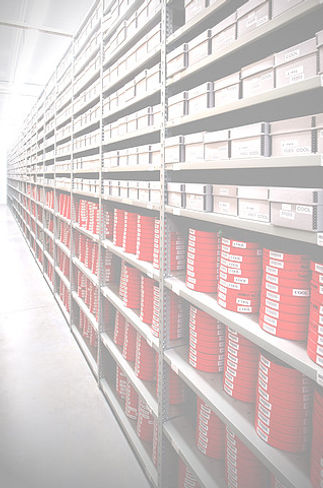
Preserving Materials of Enduring Value
Paper Records
• Archival Holdings
• Fine Art Storage
• Film Preservation
In Trust for the Future

24 Hour Stringent Environmental Control Suitable for Long Term Preservation of Permanently Valuable Records and Cultural Heritage Items
Independent Particulate Monitoring
2 Stage Fire Protection System - VESDA and Dry Sprinkler System
HEPA Filtration System
Positive Vault Pressure
Non-Stratified Temperature and Humidity Conditions
Shelving Elevated 4" Above Ground Level
Four-Hour Fire Rated Walls and Self-Contained Vaults
Building Within a Building Construction
Pitched Roof
Hermetically Sealed Exterior Building Envelope
N+1 Redundancy
Located Outside of Pearson International Airport's Flight Path
Located 1 km From Railway Tracks
Located Above The 100 Year Floodplain
24 Hour Security, CCTV Monitored
Single Point of Entry and Exit Through Use of Key Scan Access
All Materials Retrieved and Re-Filed by Hand with Minimal Use of Mechanical Handling Equipment
Guaranteed 100% Accurate Service Delivery in 3 Hours or Less
100% Accurate Inventory
Q: What is the difference between an archives and a records centre?
An archives is the repository for the permanently valuable records of an organization due to the material’s enduring value. Once transferred to an archives, the records become available for historical research.
A records centre is a storage area for records no longer needed for everyday use. They may be temporary (awaiting destruction date), or permanent (awaiting transfer to an archives).
Q: What is a HEPA Filtration System?
A HEPA is a High-Efficiency Particulate Air filter. To qualify as HEPA the filter must satisfy certain standards of efficiency. It must remove (from the air that passes through) 99.97% of 0.3 micrometre particles, which is the most difficult size of particle to filter.
Q: Why is environmental control so important?
A collection’s life expectancy is significantly affected by the conditions in which it is stored. If the building in which the collection is housed experiences environmental problems it can cause significant damage to the material. Poor conditions can quickly lead to the need for extensive and costly conservation repair, deeming the material temporarily unavailable for study. The need for conservation repair can also lead to a less valuable item.
The Archives One vaults exceed AA “Precision Control” Class specifications for Museums, Gallery, Library, and Archival collections with precision controlled humidity of 40% relative humidity (rh) ± 5% and temperatures of 18ºC ± 2ºC. A Cold Vault with precision controlled humidity of 30%rh ± 5% and temperature of -6ºC ± 2ºC is provided for collections that are considered chemically unstable such as colour based film. A Cool Vault providing precision controlled humidity of 30%rh and temperature of 10ºC ± 2ºC addresses the preservation of black & white film, microfilm, and other similar collections. To further ensure humidity and temperature stability and integrity each vault is positive pressurized.
Q: What threat do particulate pollutants pose to my collection, and how will monitoring be beneficial?
Particulate pollutants include grit, smoke, dust, etc. They are generally abrasive and acidic, and can be highly reactive chemically.
Particulate monitoring is a procedure undertaken by a trained engineer, conservator, or consultant through use of specialized equipment to ensure safe air quality for the proper preservation of permanently valuable records.
At Archives ONE a multi-stage air filtration system designed around TRUE certified HEPA filters ensures air quality in the vaults is free of damaging contaminants and particulates. In addition, the facility is monitored annually by a trained engineer as confirmation of a continuously pristine environment.
Q: What does N+1 Redundancy mean?
N+1 is a form of resilience ensuring system availability in the event of component failure. Components (N) have at least one backup component (+1).
All mechanical systems at Archives ONE have been designed and constructed using N+1 redundancy as per contractual requirements outlined by the Archives of Ontario.
Q: What is the 100 Year Floodplain?
A: The 100-year floodplain is the land that is predicted to flood during a 100-year storm, which has a 1% chance of occurring in any given year. You may also hear the 100-year floodplain called the 1% annual chance floodplain or base flood. Areas within the 100-year floodplain may flood in much smaller storms as well.
The photos to the left illustrate the disastrous outcome at the Archives of Ontario after flooding severely damaged much of their collection. Archives One LP is located outside of the 100 Year Floodplain, and provides the additional risk mitigating step of ensuring that all shelving is located 10.160cm (4") above ground level.